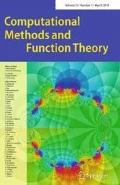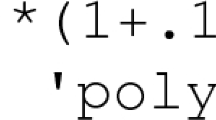Abstract
We study conformal mappings from the unit disk (or a rectangle) to one-tooth gear-shaped planar domains from the point of view of the Schwarzian derivative, with emphasis on numerical considerations. Applications are given to evaluation of a singular integral, mapping to the complement of an annular rectangle, and symmetric multitooth domains.










Similar content being viewed by others
References
Barnard, R.W., Pearce, K.: Rounding corners of gearlike domains and the omitted area problem. J. Comput. Appl. Math. 14(1–2), 217–226 (1986). (Special issue on numerical conformal mapping)
Brown, P.: Conformal mapping of a gear domain with one tooth. Quaest. Math. 33(3), 277–289 (2010)
Brown, P., Porter, R.M.: Conformal mapping of circular quadrilaterals and Weierstrass elliptic functions. Comput. Methods Funct. Theory 11(2), 463–486 (2011)
Brown, P., Porter, R.M.: Gears, pregears and related domains. Complex Var. Elliptic Equ. (2015). doi:10.1080/17476933.2015.1057715
Driscoll, T.A., Trefethen, L.N.: Schwarz-Christoffel Mapping. In: Cambridge Monogr. Appl. Comput. Math. Cambridge University Press, Cambridge (2002)
Duren, P., Pfaltzgraff, J.: Robin capacity and extremal length. J. Math. Anal. Appl. 179(1), 110–119 (1993)
Faigle, U., Kern, W., Still, G.: Algorithmic principles of mathematical programming. In: Kluwer Texts in the Mathematical Sciences, vol. 24. Kluwer Academic Publishers, Dordrecht (2002)
Goodman, A.W.: Conformal mapping onto certain curvilinear polygons. Univ. Nac. Tucuman Rev. Ser. A 13, 20–26 (1960)
Hakula, H., Rasila, A., Vuorinen, M.: On moduli of rings and quadrilaterals: algorithms and experiments. SIAM J. Sci. Comput. 33(1), 279–302 (2011)
Hakula, H., Rasila, A., Vuorinen, M.: Computation of exterior moduli of quadrilaterals. Electron. Trans. Numer. Anal. 40, 436–451 (2013)
Henrici, P.: Applied and Computational Complex Analysis, vol. 3. Wiley, New York (1986)
Hille, E.: Analytic function theory. Introductions to Higher Mathematics, vol. 2. Ginn and Co., Boston (1962)
Hyvönen, N.: Complete electrode model of electrical impedance tomography: approximation properties and characterization of inclusions. SIAM J. Appl. Math. 64(3), 902–931 (2004)
Kravchenko, V.V., Porter, R.M.: Spectral parameter power series for Sturm–Liouville problems. Math. Methods Appl. Sci. 33, 459–468 (2010)
Kravchenko, V.V., Porter, R.M.: Conformal mapping of right circular quadrilaterals. Complex Var. Elliptic Equ. 56(5), 399–415 (2011)
Kühnau, R.: The conformal module of quadrilaterals and of rings. In: The Handbook of Complex Analysis: geometric function theory, vol. 2, pp. 99–129 (2005)
Lehto, O., Virtanen, K.I.: Quasiconformal mappings in the plane. Die Grundlehren der mathematischen Wissenschaften, vol. 126, 2nd edn. Springer, New York (1973)
Nehari, Z.: Conformal Mapping. McGraw-Hill Book Co., New York (1952)
Nishimiya, H.: Conformal mapping onto gearlike domain. Kodai Math. Sem. Rep. 16(4), 243–248 (1964)
Papamichael, N., Stylianopoulos, N.: Numerical Conformal Mapping: Domain Decomposition and the Mapping of Quadrilaterals. World Scientific Publishing Co. Pte. Ltd., Hackensack (2010)
Pearce, K.: A constructive method for numerically computing conformal mappings for gearlike domains. SIAM J. Sci. Stat. Comput. 12(2), 231–246 (1991)
Porter, R.M.: Numerical calculation of conformal mapping to a disk minus finitely many horocycles. Comput. Methods Funct. Theory 5(2), 471–488 (2005)
Vuorinen, M., Zhang, X.: On exterior moduli of quadrilaterals and special functions. J. Fixed Point Theory Appl. 13(1), 215–230 (2013)
Whittaker, E.T., Watson, G.N.: A Course in Modern Analysis. Cambridge University Press, Cambridge (1927)
Author information
Authors and Affiliations
Corresponding author
Additional information
Communicated by Darren Crowdy.
P. R. Brown and R. M. Porter: Partially supported by CONACyT Grant 166183.
Appendix: SPPS Method
Appendix: SPPS Method
The sequence \(I_n\) of iterated integrals generated by an arbitrary pair of functions \((q_0,q_1)\) is defined recursively by setting \(I_0=1\) identically and for \(n\ge 1\),
where \(q_{n+2j}=q_n\) for \(j=1,2,\dots \)
Proposition 7.1
[14] Let \(\psi _0\) and \(\psi _1\) be given, and suppose that \(y_\infty \) is a non-vanishing solution of
on the interval [0, 1], where \(\lambda _\infty \) is any constant. Choose \(q_0=1/y_\infty ^2\), \(q_1=\psi _1\,y_\infty ^2\) and define \(X^{(n)}\), \(\widetilde{X}^{(n)}\) to be the two sequences of iterated integrals generated by \((q_0,q_1)\) and by \((q_1,q_0)\), respectively. Then for each \(\lambda \in \mathbb {C}\) the functions
are linearly independent solutions of the equation
on [0, 1]. Further, the series for \(y_1\) and \(y_2\) converge uniformly on [0, 1] for every \(\lambda \).
It is a straightforward matter to obtain the appropriate linear combination of solutions with desired 1-jets at \(z=0\), for example (0, 1) and (1, 0).
Rights and permissions
About this article
Cite this article
Brown, P.R., Porter, R.M. Numerical Conformal Mapping to One-Tooth Gear-Shaped Domains and Applications. Comput. Methods Funct. Theory 16, 319–345 (2016). https://doi.org/10.1007/s40315-015-0149-4
Received:
Revised:
Accepted:
Published:
Issue Date:
DOI: https://doi.org/10.1007/s40315-015-0149-4
Keywords
- Conformal mapping
- Accessory parameter
- Schwarzian derivative
- Gearlike domain
- Sturm–Liouville problem
- Spectral parameter power series
- Conformal modulus
- Topological quadrilateral
- Weierstrass elliptic function




